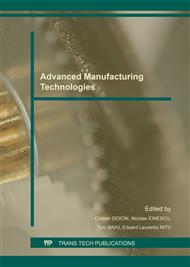[1]
A.W.L. Yao, Applications of 3D scanning and reverse engineering techniques for quality control of quick response products, The International Journal of Advanced Manufacturing Technology November 2005, Volume 26, Issue 11, pp.1284-1288.
DOI: 10.1007/s00170-004-2116-5
Google Scholar
[2]
A. ManorAffiliated withDepartment of Mechanical Engineering, CMSR Laboratory for Computer Graphics and CAD, A. Fischer, Reverse Engineering of 3D Models Based on Image Processing and 3D Scanning Techniques, Chapter Geometric Modelling, Volume 75 (2001).
DOI: 10.1007/978-0-387-35490-3_23
Google Scholar
[3]
R. Sitnik, M. Karaszewski, Automated Processing of Data from 3D Scanning of Cultural Heritage Objects. Chapter Digital Heritage Volume 6436 (2010) of the series Lecture Notes in Computer Science pp.28-41.
DOI: 10.1007/978-3-642-16873-4_3
Google Scholar
[4]
M. Schaich, From 3D Scanning to Analytical Heritage Documentation. Chapter Lasers in the Conservation of Artworks, Volume 116 (2007) of the series Springer proceedings in physics pp.463-471.
DOI: 10.1007/978-3-540-72310-7_55
Google Scholar
[5]
M. Ares, S. Royo, et al, 3D Scanning System for In-Vivo Imaging of Human Body. Chapter in Fringe 2013, pp.899-902.
Google Scholar
[6]
S. McAtee, M. Dunn et al. Simulation scan comparison for process monitoring using 3D scanning in manufacturing environments. The International Journal of Advanced Manufacturing Technology, September 2014, Volume 74, Issue 5, pp.823-834.
DOI: 10.1007/s00170-014-6037-7
Google Scholar
[7]
Ismael Daribo, Ryo Furukawa et al. Efficient Rate-Distortion Compression of Dynamic Point Cloud for Grid-Pattern-Based 3D Scanning Systems. 3D Research, March (2012).
DOI: 10.1007/3dres.01(2012)2
Google Scholar
[8]
H. Li, H. Yang, M. Zhan, Z. C. Sun,R. J. Gu, Role of mandrel in NC precision bending process of thin-walled tube. International Journal of Machine Tools & Manufacture. Vol. 47, 2007, pp.1164-1175.
DOI: 10.1016/j.ijmachtools.2006.09.001
Google Scholar
[9]
Y. Lin, H. Yang, ZS. Zhao, M Zhan, 3D FEM simulation of NC precision bending process of thin-walled tube. Proceedings of the 5th International Conference on Frontiers of Design and Manufacturing, Vol 1, 200, pp.626-628.
Google Scholar
[10]
A. Manolescu, A. Fota, G. Oancea, G. (2012). Recognizing Algorithm for Digitized Rotational Parts, Proceedings of the ASME 11th Biennial Conference on Engineering Systems Design and Analysis (ESDA) 2012, Vol 4. pp.457-466.
DOI: 10.1115/esda2012-82334
Google Scholar


